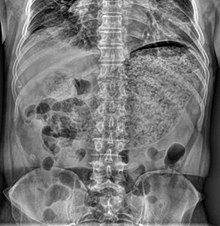
Back شلل المعدة Arabic Gastroparese Danish Magenlähmung German Γαστροπάρεση Greek Gastroparesia Spanish گاستروپارزی FA Gastroparésie French גסטרופרזיס HE Gastroparesi Italian 胃不全麻痺 Japanese
| Gastroparesis | |
|---|---|
 | |
| Simple abdominal X-ray shows gastric distension with a large amount of material in the stomach, suggesting severe gastric hypomotility | |
| Pronunciation |
|
| Specialty | Gastroenterology |
| Symptoms | Nausea, vomiting, abdominal pain, feeling full after consuming very little ("early satiety") |
| Complications | Malnutrition, fatigue, weight loss, vitamin deficiencies, intestinal obstruction due to bezoars, small intestinal bacterial overgrowth |
| Causes | Damage to the vagus nerve,[2] chemotherapy-induced neuropathy,[3] autonomic neuropathy[4] |
| Risk factors | Diabetes, abdominal or esophageal surgery, infection, certain medications that slow the rate of stomach emptying, scleroderma, nervous system diseases, hypothyroidism[2] |
| Diagnostic method | Barium swallow X-ray, barium beefsteak meal, radioisotope gastric-emptying scan (GES), wireless motility capsule (WMC), serial X-ray after ingesting radiopaque markers (ROM), gastric manometry, esophagogastroduodenoscopy (EGD), stable isotope breath test |
| Differential diagnosis | Peptic ulcer disease, gastric outlet obstruction, functional dyspepsia |
| Treatment | Dietary modifications, medications to stimulate gastric emptying, medications to reduce vomiting[5] gastric electrical stimulation[6] |
Gastroparesis (gastro- from Ancient Greek γαστήρ – gaster, "stomach"; and -paresis, πάρεσις – "partial paralysis") is a medical disorder of ineffective neuromuscular contractions (peristalsis) of the stomach, resulting in food and liquid remaining in the stomach for a prolonged period of time. Stomach contents thus exit more slowly into the duodenum of the digestive tract, a medical sign called delayed gastric emptying. The opposite of this, where stomach contents exit quickly into the duodenum, is called dumping syndrome.
Symptoms include nausea, vomiting, abdominal pain, feeling full soon after beginning to eat (early satiety), abdominal bloating, and heartburn. Many or most cases are idiopathic. The most common known cause is autonomic neuropathy of the vagus nerve, which innervates the stomach. Uncontrolled diabetes mellitus is a frequent cause of this nerve damage, but trauma to the vagus nerve is also possible. Some cases may be considered post-infectious.
Diagnosis is via one or more of the following: barium swallow X-ray, barium beefsteak meal, radioisotope gastric-emptying scan, gastric manometry, esophagogastroduodenoscopy (EGD), and a stable isotope breath test. Complications include malnutrition, fatigue, weight loss, vitamin deficiencies, intestinal obstruction due to bezoars, and small intestinal bacterial overgrowth. There may also be poor glycemic control and irregular absorption of nutrients, particularly in the setting of diabetes.[7][8]
Treatment includes dietary modification, medications to stimulate gastric emptying (including some prokinetic agents), medications to reduce vomiting (including some antiemetics), and surgical approaches.[5] Additionally, gastric electrical stimulation (GES; approved on a humanitarian device exemption) can be used as treatment.[6] Nutrition may be managed variously, ranging from oral dietary modification to jejunostomy feeding tube (if oral intake is inadequate).[6] A gastroparesis diagnosis is associated with poor outcomes, and survival is generally lower among patients than in the general population.[9]
- ^ "How to pronounce gastroparesis in English". dictionary.cambridge.org.
- ^ a b Cite error: The named reference
:2was invoked but never defined (see the help page). - ^ Cite error: The named reference
cancerwas invoked but never defined (see the help page). - ^ Cite error: The named reference
:3was invoked but never defined (see the help page). - ^ a b Cite error: The named reference
Thorn2010was invoked but never defined (see the help page). - ^ a b c Camilleri M, Kuo B, Nguyen L, Vaughn VM, Petrey J, Greer K, et al. (August 2022). "ACG Clinical Guideline: Gastroparesis". The American Journal of Gastroenterology. 117 (8): 1197–1220. doi:10.14309/ajg.0000000000001874. PMC 9373497. PMID 35926490.
- ^ . In: Simpson, Kathleen Rice, Creehan, Patricia A. eds. AWHONN's Perinatal Nursing. 4th Edition. 530 Walnut Street, Philadelphia, PA 19106 USA:Lippincott Williams & Wilkins; 2014. Available from: Books@Ovid at [1]. Retrieved November 09, 2020.
- ^ Fuglsang J, Ovesen PG (2015). "Pregnancy and Delivery in a Woman with Type 1 Diabetes, Gastroparesis, and a Gastric Neurostimulator". Diabetes Care. 38 (5): e75. doi:10.2337/dc14-2959. PMID 25908160. S2CID 34451324.
- ^ Jung HK, Choung RS, Locke GR, Schleck CD, Zinsmeister AR, Szarka LA, et al. (April 2009). "The incidence, prevalence, and outcomes of patients with gastroparesis in Olmsted County, Minnesota, from 1996 to 2006". Gastroenterology. 136 (4). Elsevier BV: 1225–1233. doi:10.1053/j.gastro.2008.12.047. PMC 2705939. PMID 19249393.